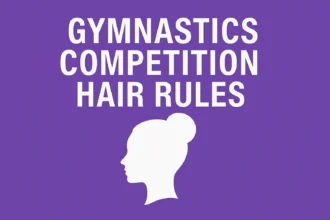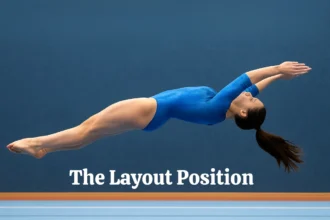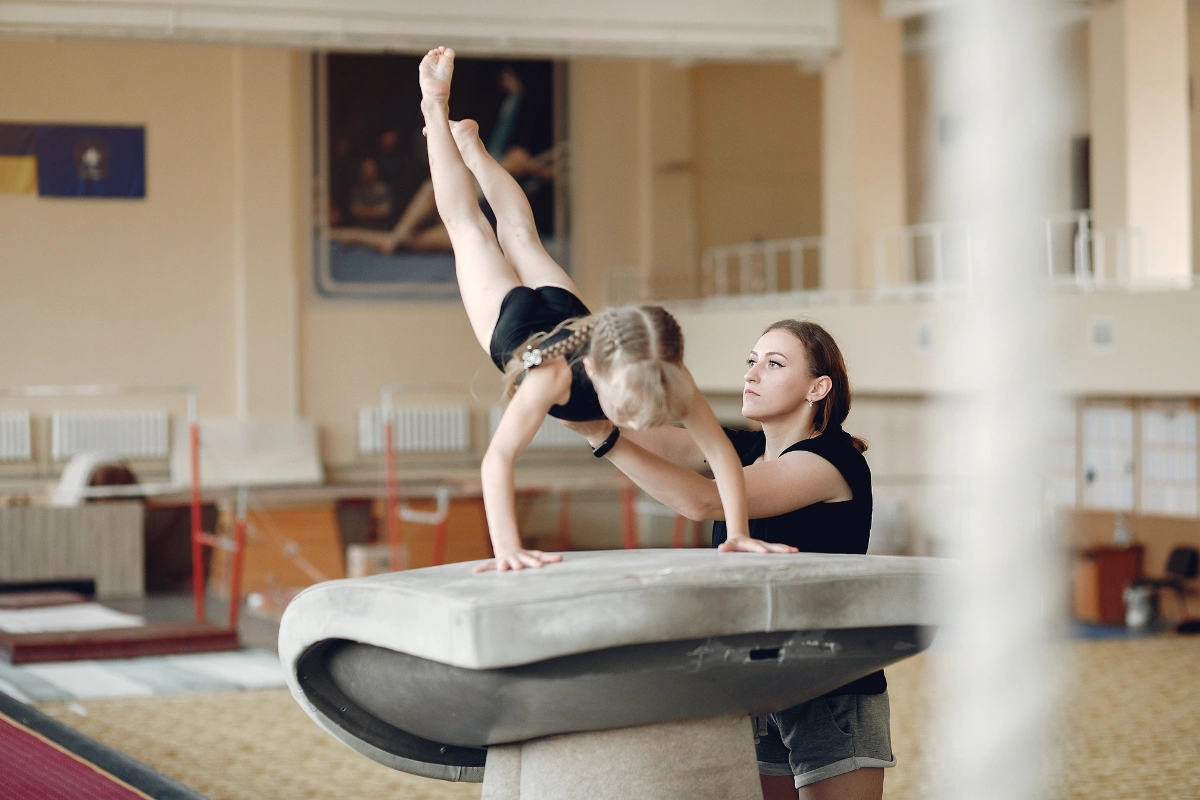Gymnastics is a sport that demands precision, strength, flexibility, and a high level of skill. To ensure the safety and success of gymnasts, especially during complex maneuvers, the practice of “spotting” is essential.
What Is Gymnastics Spotting?
Gymnastics spotting is all about supporting a gymnast—both physically and visually—while they perform a skill. The main objectives are to help the gymnast maintain the correct form, minimize the risk of injury, and boost their confidence. Typically, a spotter is a coach or a trained assistant who offers physical support or guidance to ensure the gymnast executes movements safely, especially when tackling new or more challenging skills.
Spotting is not just about catching a gymnast in case of a fall; it also involves:
- Guiding the gymnast through the correct motion of a skill.
- Providing feedback on technique and alignment.
- Offering psychological reassurance, which is vital for overcoming fear.
When Is Spotting Used in Gymnastics?
Spotting is most commonly used:
- When gymnasts are learning new skills.
- During complex or high-risk maneuvers, such as flips or twists.
- On apparatuses where the risk of falls or injuries is higher, such as the balance beam or uneven bars.
- For younger or beginner gymnasts who may lack strength or coordination.
As gymnasts become more experienced, they rely less on spotting and more on their developed skills and confidence.
How to Spot a Gymnast: General Guidelines
Spotting requires skill, focus, and proper technique to ensure both the gymnast and the spotter remain safe. Here are general guidelines:
1. Know the Skill
Before spotting any skill—whether a simple handstand or a complex tumbling pass—ensure you thoroughly understand the movement.
Know the correct body positions, the path of rotation, and the ideal takeoff and landing points. If you are unfamiliar with the skill, seek guidance from a more experienced coach or reference credible training materials.
2. Proper Positioning
Stand close enough to intervene quickly but far enough not to obstruct the gymnast’s movement. Keep a balanced stance—feet shoulder-width apart or staggered—so you can move and support effectively.
Always keep your hands ready (around chest or waist height) to guide the gymnast’s motion or catch them if needed.
3. Clear Communication
Before the skill begins, explain to the gymnast exactly how and where you will spot them (e.g., “I will place one hand on your lower back, the other on your thigh”). Use brief, clear verbal cues during the skill (“Tight core,” “Look for the landing”) to reinforce the technique.
After each attempt, discuss what went well and what can be improved. Open communication helps gymnasts feel more comfortable and builds trust.
4. Apply the Right Amount of Assistance
Give just enough support to help the gymnast complete the skill safely without becoming overly reliant on the spot.
Gradually reduce the level of physical support as the gymnast gains confidence and demonstrates consistency. Avoid “over-spotting,” which can lead to dependence and slow the gymnast’s progression.
5. Progressive Skill Building
Break complex skills into smaller drills or progressions. Ensure the gymnast has mastered each foundational step before moving on to more advanced elements.
Incorporate additional safety measures (e.g., soft mats or crash pads) during early learning stages or when attempting a new skill.
6. Build Trust and Confidence
Encourage a supportive environment where the gymnast feels comfortable voicing concerns. Offer positive reinforcement when skills are performed correctly.
A trusting gymnast will commit more fully to new skills, speeding up the learning process and improving performance.
Common Spotting Techniques for Gymnastics
Spotting is an essential skill that ensures gymnasts can safely perform skills while developing their technique. The right spotting method depends on the gymnast’s ability, the skill being performed, and the apparatus involved.
1. Shadow Spotting (Light Touch)
Shadow spotting is a minimal-contact technique where the spotter hovers their hands close to the gymnast’s body without providing constant physical contact. The spotter is ready to intervene if necessary but primarily offers guidance through their presence.
Shadow spotting builds the gymnast’s confidence by allowing them to perform mostly independently, while the spotter provides a safety net. It also helps the gymnast develop trust in their abilities and become more self-reliant.
When to Use:
This technique is ideal for skills where the gymnast has a solid understanding of the movement and can perform it independently, but still needs the safety of having the spotter nearby for reassurance. Commonly used for skills like forward rolls, cartwheels, and basic tumbling.
2. Shoulder or Hip Support
The spotter places one or both hands on the gymnast’s shoulders or hips, providing guidance and stability during the skill. This contact helps ensure proper alignment and control.
Shoulder or hip support helps maintain control over the gymnast’s center of gravity, preventing twists, falls, and loss of alignment. It also gives the spotter more control to make adjustments in real-time, ensuring smoother execution of the skill.
When to Use:
Ideal for skills that require a stable core, such as handstands, cartwheels, back handsprings, or balance beam routines. It’s also helpful during transitions or moments when the gymnast needs added stability.
3. Double-Arm Support
In double-arm support, the spotter uses both hands: one arm typically goes around the gymnast’s waist (or lower back), and the other is placed near their thighs or upper back to assist with managing rotation and control height.
This method is most useful for more dynamic tumbling passes, such as back tucks or layouts, or bar dismounts where extra lift and rotation control are needed. It’s especially helpful when the gymnast is attempting a new or complex skill.
When to Use:
This technique is often used for more dynamic skills like back tucks, layouts, or bar dismounts, where additional lift and rotation control are required.
4. Hand-to-Hand Support
In hand-to-hand support, the spotter makes contact with the gymnast’s wrists or hands, guiding the arms into correct placement during the skill.
Hand-to-hand spotting helps the gymnast develop upper-body strength and awareness. By ensuring safe hand placement, it reduces the risk of injury from improper form, especially on apparatuses like bars.
When to Use:
This method is particularly useful for skills like walkovers, handsprings, and transitions on bars (e.g., pullovers or cast handstands).
5. Belt/Harness Spotting
Belt or harness spotting uses a specialized belt or harness attached to overhead cables or straps. The spotter can adjust the gymnast’s rotation and descent by controlling the ropes.
Belt or harness spotting allows gymnasts to attempt advanced skills with reduced risk, speeding up their learning process. It provides an additional layer of safety, particularly for moves that involve high levels of rotation or flipping.
When to Use:
This technique is used for high-level skills like back or front saltos, complex tumbling passes (e.g., double backs), or trampoline work. It’s particularly beneficial when learning skills with a higher risk of injury.
Apparatus-Specific Spotting Techniques
Spotting in gymnastics is a critical practice that ensures safety and facilitates skill development across various apparatuses. Each apparatus presents unique challenges, necessitating tailored spotting techniques to accommodate specific movements and positions. Below is an overview of essential spotting methods for key gymnastics apparatuses:
Vault
In the vault event, gymnasts execute powerful, rapid movements involving a sprint, springboard launch, and propulsion off the vaulting table. Spotters must be highly attentive and positioned strategically to react swiftly.
Their role includes assisting the gymnast during the post-flight phase to ensure a safe landing, especially when the gymnast is attempting new or complex vaults. Proper hand placement and readiness to support the gymnast’s back or shoulders are essential to prevent falls and injuries.
Uneven Bars
The uneven bars require gymnasts to perform continuous swinging and transitional movements between two bars set at different heights. Spotting here involves being prepared to assist during release moves, catches, and transitions to prevent falls.
The spotter should position themselves to support the gymnast’s midsection or hips, providing guidance and ensuring the gymnast maintains proper form throughout the routine. Effective communication and anticipation of the gymnast’s movements are crucial for timely assistance.
Balance Beam
The balance beam’s narrow surface demands exceptional balance and precision. Spotters should stand close to the beam, ready to provide immediate support if the gymnast loses balance.
Assistance often involves guiding the gymnast’s hips or back during complex skills like back handsprings or aerial maneuvers. The spotter’s presence offers psychological reassurance, enabling the gymnast to perform with increased confidence.
Floor Exercise
During floor routines, gymnasts perform a series of tumbling passes, leaps, and dance elements. Spotting in this context is typically reserved for the learning phase of complex tumbling skills.
The spotter assists by providing support during flips and twists, ensuring the gymnast completes rotations safely and lands properly. As the gymnast becomes more proficient, the spotter’s assistance is gradually reduced to promote independence.
Pommel Horse (Men’s Gymnastics)
In men’s gymnastics, the pommel horse requires continuous circular movements and balance. Spotting involves guiding the gymnast’s legs and hips to maintain rhythm and prevent falls during complex sequences.
The spotter must be attentive to the gymnast’s form and provide support without disrupting the flow of the routine.
Rings (Men’s Gymnastics)
The still rings demand significant upper-body strength and control. Spotters assist by supporting the gymnast during mounting and dismounting, as well as during strength holds and transitions between positions. Proper spotting ensures the gymnast maintains control and reduces the risk of shoulder or arm injuries.
Mastering these apparatus-specific spotting techniques requires practice and a deep understanding of each event’s unique demands. Spotters should be attentive, responsive, and maintain clear communication with the gymnast to ensure safety and effective skill execution.




